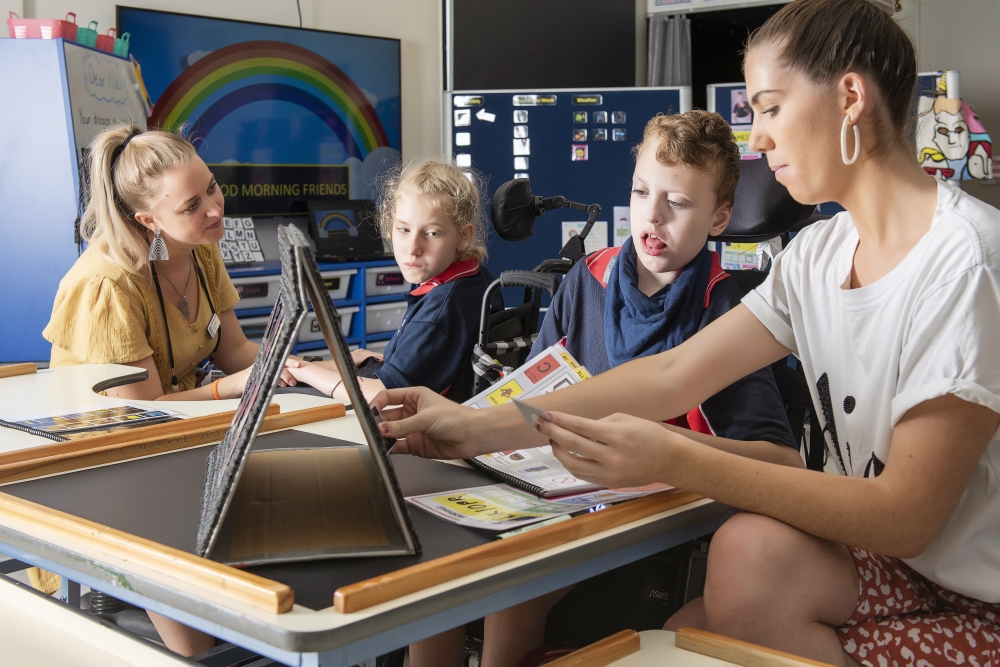
Red Hill Special School caters for students with an intellectual disability Prep to Year 12. Red Hill Special School’s AAC policy has been developed in accordance with the guidelines of the Communication Bill of Rights.
Communication is the foundation of all learning and we are committed to providing communication opportunities and supports for students to experience success. This policy outlines the aims, AAC procedures and expectations for communication at Red Hill Special School.
Aims
Red Hill Special School aims to:
- Adopt a multi-modal communication approach throughout the school where students have access to individual communication systems throughout the day and all communication modes are acknowledged, used and valued.
- Create and provide opportunities for real life communication that is embedded in the curriculum and across school environments, enabling students to practice and use their communication to the best of their ability.
- Support staff, parents and caregivers to work together to provide productive learning communities, which support the communication rights and individual needs of all students.
- Use a team-based approach to supporting our students’ communication through the belief that communication occurs all day, every day and we are all responsible for making sure this happens for everyone.
Comprehensive Communication at Red Hill Special School
Red Hill Special School recognises that every individual has the right to communicate. All staff at Red Hill Special School receive extensive training in best practice in AAC and in being good communication partners, and an understanding that a comprehensive AAC system (e.g. Proloquo2Go, PODD, LAMP, AUSLAN and Key Word Sign, etc) supports an individual to develop in the four areas of communicative competence.
The Participation Model (Beukelman & Mirenda, 2013) is the current model of best practice in AAC. This provides an overall framework of considerations associated with enabling people with complex communication needs to communicate as their peers do. Working within the parameters of the Participation Model, we aim to support each individual to be the best communicator that they can with their current communication system. We also provide support for them to reach a higher level of communicative competence, including supporting a system that students will use in the future.
We believe in students’ ability to communicate and use language and aim to give them a system that enables them to develop and use language. We recognise that there are many strategies good communication partners use including presuming competence and attributing meaning when interacting with emergent communicators. We also recognise that aided language stimulation including modelling throughout the day is an important technique and that a comprehensive AAC system is required for us to be able to do this throughout the school day.
Staff at Red Hill Special School wear Aided Language Displays (ALD’s) with quick chat vocabulary to support students in a range of environments, activities and for varying levels of communicative function. Staff also carry and use comprehensive AAC systems (high tech, low tech, signing, speech) that are appropriate for the class they are in, and model for a range of purposes across the school day.
Finally, we understand that all communication is multimodal and that all forms of communication are as valid as each other – this includes facial expression, natural gesture, vocalisations, verbalisations, signing, high and low tech aided AAC.
High Tech and Low Tech AAC at Red Hill Special School
Red Hill Special School uses aided language input and output in all classrooms as well as speech and signing. We believe that every individual with complex communication needs is entitled to both low and high tech AAC to give them a voice in all environments. Many classrooms at Red Hill Special School use a range of high and low-tech AAC systems. These include (but are not limited to) a variety of iPad apps, speech generating devices, aided language displays, core word boards and a variety of PODD Books.
At Red Hill Special School, we also recognise that students access AAC in a variety of ways, and that symbol sets require individual considerations. Students have access to High Contrast materials for individuals with a Vision Impairment or who have difficulty with complex visual arrays. There are also Alternative Access methods such as Eye Gaze devices (eye pointing), Partner Assisted Scanning, switch access and more, for students who have physical impairments that impact their ability to point with direct access (or touch).
It is important that each student (and staff member) has access to both low and high tech AAC for a range of reasons. For example, there are times in every day where a high-tech system may not be available or appropriate for modelling. This could be due to lack of battery, the environment e.g. during a water play activity, or just because it is out of reach. The low-tech systems and boards ensure we still have AAC available at all times without having to worry about these factors. They also have the advantage of being wearable so they are with us at all times, ensuring communication access for students in all school environments. We also understand the importance of high tech as it produces voice output, enables access to features such as text-to-speech and offers more just-in-time AAC features that let us add vocabulary on the go.
Please note: Red Hill Special School recognises that there are a range of AAC options and that different individuals may require different options. We are happy to support any comprehensive AAC system recommended by a speech pathologist for an individual student.